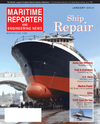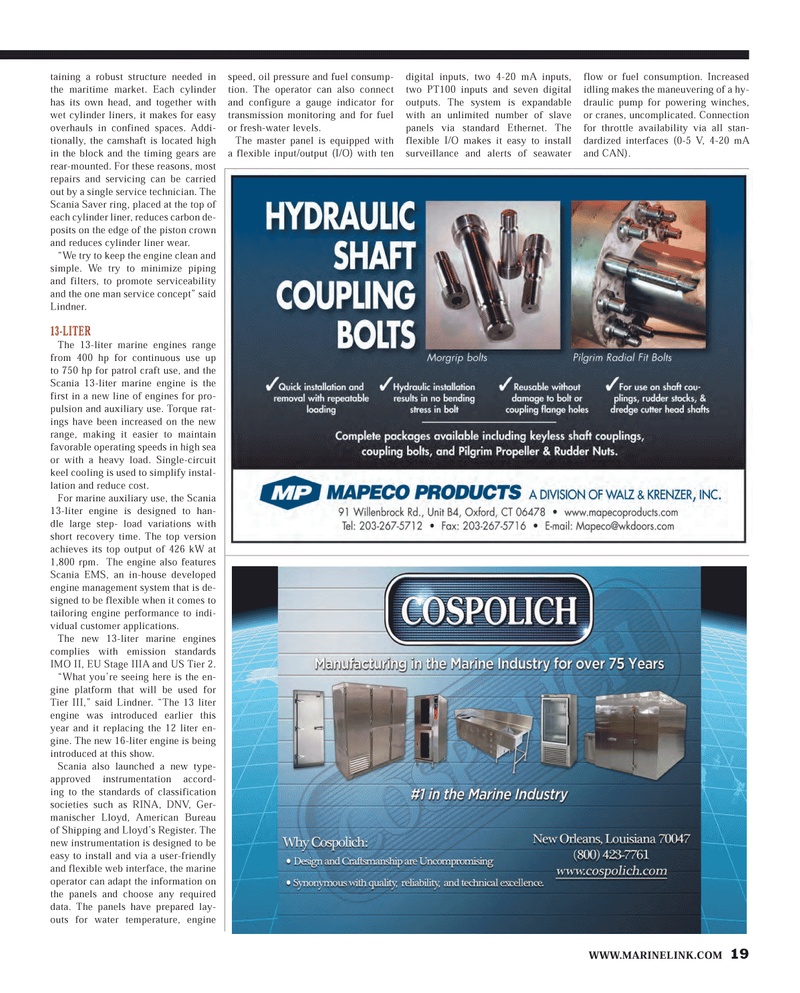
Page 19: of Maritime Reporter Magazine (January 2013)
Ship Repair & Conversion
Read this page in Pdf, Flash or Html5 edition of January 2013 Maritime Reporter Magazine
WWW.MARINELINK.COM 19taining a robust structure needed in the maritime market. Each cylinder has its own head, and together with wet cylinder liners, it makes for easy overhauls in confined spaces. Addi- tionally, the camshaft is located high in the block and the timing gears are rear-mounted. For these reasons, most repairs and servicing can be carried out by a single service technician. The Scania Saver ring, placed at the top of each cylinder liner, reduces carbon de- posits on the edge of the piston crown and reduces cylinder liner wear. ?We try to keep the engine clean and simple. We try to minimize piping and filters, to promote serviceability and the one man service concept? said Lindner. 13-LITERThe 13-liter marine engines range from 400 hp for continuous use up to 750 hp for patrol craft use, and the Scania 13-liter marine engine is the first in a new line of engines for pro-pulsion and auxiliary use. Torque rat- ings have been increased on the new range, making it easier to maintain favorable operating speeds in high sea or with a heavy load. Single-circuit keel cooling is used to simplify instal-lation and reduce cost.For marine auxiliary use, the Scania 13-liter engine is designed to han-dle large step- load variations with short recovery time. The top version achieves its top output of 426 kW at 1,800 rpm. The engine also features Scania EMS, an in-house developed engine management system that is de-signed to be flexible when it comes to tailoring engine performance to indi-vidual customer applications.The new 13-liter marine engines complies with emission standards IMO II, EU Stage IIIA and US Tier 2. ?What you?re seeing here is the en-gine platform that will be used for Tier III,? said Lindner. ?The 13 liter engine was introduced earlier this year and it replacing the 12 liter en-gine. The new 16-liter engine is being introduced at this show. Scania also launched a new type-approved instrumentation accord-ing to the standards of classification societies such as RINA, DNV, Ger- manischer Lloyd, American Bureau of Shipping and Lloyd?s Register. The new instrumentation is designed to be easy to install and via a user-friendly and flexible web interface, the marine operator can adapt the information on the panels and choose any required data. The panels have prepared lay- outs for water temperature, engine speed, oil pressure and fuel consump-tion. The operator can also connect and configure a gauge indicator for transmission monitoring and for fuel or fresh-water levels.The master panel is equipped with a flexible input/output (I/O) with ten digital inputs, two 4-20 mA inputs, two PT100 inputs and seven digital outputs. The system is expandable with an unlimited number of slave panels via standard Ethernet. The flexible I/O makes it easy to install surveillance and alerts of seawater flow or fuel consumption. Increased idling makes the maneuvering of a hy-draulic pump for powering winches, or cranes, uncomplicated. Connection for throttle availability via all stan-dardized interfaces (0-5 V, 4-20 mA and CAN).MR #1 (18-25).indd 19MR #1 (18-25).indd 191/2/2013 10:58:50 AM1/2/2013 10:58:50 AM

 18
18

 20
20
